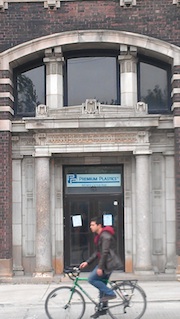May Day: Labor History Tour Vivifies Tragic Origins (original) (raw)
History Wed May 16 2012
By David Pritchard
126 years ago this month, workers and reform activists in Chicago were reeling from the aftermath of what remains the most influential and memorialized event in American labor history. On the evening of May 4, 1886, a spontaneous protest took shape at Haymarket Square (Randolph and Desplaines, Fulton River District) as labor leaders learned of police and corporate aggression against striking workers at the McCormick Harvesting Machine Company on the previous day. The strikers had every intention of remaining peaceful; few that night had any idea they were marching into history.

The legacy of May 4, 1886, still resonates with labor activists and allies today. Here, handwritten notes and transcripts of condemned strikers' speeches adorn a statue commemorating the Haymarket Affair near the corner of N. Desplaines and W. Couch Place.
Back then, Chicago was acknowledged as the center of the American labor movement. The major issue of the time was the eight-hour workday, which national labor groups had adopted as a cause célèbre two years prior. Horrors! Anarchy might surely reign!
To the protesters' misfortune, Haymarket Square had the disadvantage of being located across from a police station (apparently, occupying doomed protest spots remains another distinct specialty of Chicago radicals). As darkness fell, a phalanx of police marched toward the crowd to break up the rally. Suddenly, a stick of dynamite -- which had just been invented by Alfred Nobel, of Peace Prize fame -- sailed over the heads of the police and exploded in the street. The device was thrown by an "agitator" whose identity and motives have eluded historians ever since. What is certain is that the police immediately opened fire on the crowd. In the end, seven officers and four laborers lay dead, evidently all from police bullets. In the subsequent weeks, numerous men were hanged in connection to the explosion, most of whom were later exonerated. The event has been commemorated worldwide on May Day ever since.
On a bus and walking tour offered by the Chicago Cultural Center called "STRIKE! Chicago Labor History," these struggles and many others of our working forebears come alive, thanks to the charisma of the tour leader, Tim Samuelson. Samuelson, a Rogers Park native, sported a smart periwinkle turtleneck, grey cropped hair, and one of thickest Chicago accents around. Despite persistent trouble distinguishing his lefts from his rights, the man has a prodigious block-by-block knowledge of the city's social, political and architectural history. At one point, he essentially admitted to the bus full of 30-odd passengers that he was piecing together this tour from memory as we rode along.

Tim Samuelson, a tour guide for the Chicago Cultural Center, gestures upward at a union meeting hall dating from the 1860's. "Many people will tell you that the whole city of Chicago burned down in the Great Fire (of 1871)," says Samuelson. "This isn't true."
The value of a tour is that many accounts of a past event rarely tell you where exactly it happened, or what stands on the site now. In addition to the pitfalls of shifting urban geography, the powers-that-be might also strive to keep you from feeling the radicalizing weightiness of historical presence. I was chilled to learn that a Pilsen underpass (Metra BNSF Railway bridge at Halsted and 16th) that I had walked or biked under many times was in fact the site of the 'Battle of the Viaduct,' in which U.S. soldiers, fresh back from the one-sided slaughter of the Indian Wars, killed thirty striking railroad workers and their allies in 1877.
Being a pilot tour of sorts, there is room to expand or refine. While the crowd was treated to a full-blown, traffic-stopping reenactment of the tragedy at Haymarket Square, other notable spots in Chicago's labor history -- such as the Pullman or Memorial Day Massacre sites, the Stockyards, the Republic Windows and Doors factory on Goose Island, or even the ongoing occupation of the Woodlawn Mental Health Clinic by workers and patients -- were not on the itinerary. In fact, the last 100 years were little discussed, as if union halls must be viewed as architectural wonders, and workers like mute Egyptian figures staring back from bas-reliefs. The meandering tour could have benefited from more precise planning and the courage to venture out of the Near West Side and Pilsen. Many of the stops seemed to be for the purpose of highlighting Chicago's remaining pre-Fire structures, many of which were factories or union halls built along the South Chicago River.

A youth rides past yet another old building on the Chicago River, where some event or another relevant to labor history apparently occurred.
Still, the experience was enjoyable, conversations with the other passengers enlivening, and lunch included. While I alone lowered the average age of the ticket-holding crowd by perhaps five years, I was especially impressed with the acumen of the young twenty-something volunteers who assisted Tim with the proceedings. This sort of interest in Chicago's history among the young demographic should hearten both preservationists and local activists alike.
The Chicago Cultural Center offers an impressive array of themed and neighborhood tours through its Chicago Neighborhood Tours program throughout the spring and summer. This Saturday May 19, for example, Dan Pogorzelski, who cofounded forgottenchicago.com and is Executive Director at the Greater Avondale Chamber of Commerce and Vice President of the Northwest Chicago Historical Society, stops inside St. Hyacinth Basilica, one of Chicago's oldest Polish parishes, and visits Prairie-style landmark Carl Schurz High School on Avondale & Old Irving. There is also a particularly intriguing tour on June 2 called "Hops and Barley". The "STRIKE! Chicago Labor History" tour repeats on August 25. For more information about the tour program, visit explorechicago.org.
